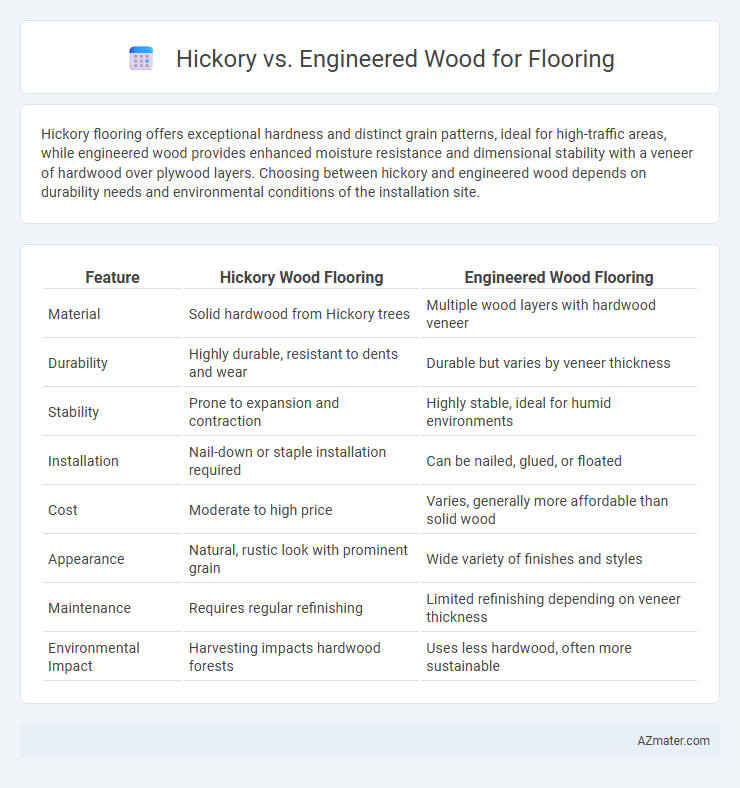Hickory flooring offers exceptional hardness and distinct grain patterns, ideal for high-traffic areas, while engineered wood provides enhanced moisture resistance and dimensional stability with a veneer of hardwood over plywood layers. Choosing between hickory and engineered wood depends on durability needs and environmental conditions of the installation site.
Table of Comparison
| Feature | Hickory Wood Flooring | Engineered Wood Flooring |
|---|---|---|
| Material | Solid hardwood from Hickory trees | Multiple wood layers with hardwood veneer |
| Durability | Highly durable, resistant to dents and wear | Durable but varies by veneer thickness |
| Stability | Prone to expansion and contraction | Highly stable, ideal for humid environments |
| Installation | Nail-down or staple installation required | Can be nailed, glued, or floated |
| Cost | Moderate to high price | Varies, generally more affordable than solid wood |
| Appearance | Natural, rustic look with prominent grain | Wide variety of finishes and styles |
| Maintenance | Requires regular refinishing | Limited refinishing depending on veneer thickness |
| Environmental Impact | Harvesting impacts hardwood forests | Uses less hardwood, often more sustainable |
Overview of Hickory and Engineered Wood Flooring
Hickory flooring is known for its exceptional hardness, durability, and distinctive grain patterns, making it a popular choice for high-traffic areas and traditional designs. Engineered wood flooring features a multi-layer construction with a hardwood veneer atop plywood or high-density fiberboard, offering enhanced stability and resistance to humidity and temperature fluctuations. Both options provide aesthetic appeal, but hickory delivers natural strength while engineered wood excels in versatility and installation ease.
Appearance and Aesthetic Differences
Hickory flooring boasts a distinctive, rustic appearance with prominent grain patterns and natural color variations, ranging from creamy whites to rich browns, providing a warm and dynamic aesthetic. Engineered wood offers a wide variety of finishes and wood species that can mimic exotic or traditional hardwood looks with consistent texture and color, ensuring a uniform appearance across the floor. Hickory's bold, character-rich surface contrasts with engineered wood's tailored elegance, making it ideal for achieving either a natural, rugged vibe or a refined, modern design in interior spaces.
Durability and Hardness Comparison
Hickory flooring offers exceptional durability with a Janka hardness rating of 1820, making it one of the hardest domestic hardwoods ideal for high-traffic areas. Engineered wood flooring combines a hardwood veneer with plywood layers, providing enhanced stability and resistance to moisture but generally has a lower hardness rating depending on the species used for the top layer. While hickory excels in hardness and long-term wear resistance, engineered wood is favored for environments prone to humidity fluctuations due to its dimensional stability.
Installation Methods and Ease
Hickory flooring typically requires traditional installation methods such as nailing or stapling, which demand professional skills due to the wood's hardness and density. Engineered wood offers versatile installation options including click-lock, glue-down, and floating floor methods, making it more accessible for DIY projects. The stability of engineered wood reduces the need for acclimation and subfloor preparation, streamlining the installation process compared to solid hickory.
Moisture and Climate Resistance
Hickory flooring offers natural hardness and moderate moisture resistance, making it suitable for areas with stable indoor climates but less ideal for high humidity environments. Engineered wood flooring features a plywood core layered construction, enhancing dimensional stability and superior resistance to moisture and climate fluctuations. This makes engineered wood a preferred choice for basements, kitchens, and regions with varying temperature and humidity levels.
Maintenance and Care Requirements
Hickory flooring requires regular sweeping and occasional refinishing to maintain its durability and natural beauty, thriving with routine cleaning using a hardwood floor cleaner. Engineered wood flooring offers easier maintenance thanks to its layered construction, resisting moisture better and allowing for simpler cleaning with damp mops without warping concerns. Both flooring types benefit from protective measures like furniture pads and avoiding excessive water exposure to extend their lifespan and preserve appearance.
Cost Comparison
Hickory flooring typically costs between $8 to $12 per square foot, making it a mid-to-high range solid hardwood option known for durability and natural grain patterns. Engineered wood flooring varies widely, averaging $4 to $10 per square foot depending on the wood veneer and core materials, offering a cost-effective alternative with enhanced moisture resistance. When comparing total installation expenses, engineered wood generally incurs lower labor costs due to easier handling and compatibility with various subfloors.
Environmental Impact and Sustainability
Hickory flooring is derived from solid hardwood trees, which generally requires longer growth periods and can contribute to deforestation if not sourced responsibly, whereas engineered wood utilizes a plywood core topped with a hardwood veneer, allowing for more efficient use of timber and less impact on forests. Engineered wood often incorporates recycled materials and utilizes less wood per plank, reducing the carbon footprint and promoting sustainability through better resource management. Preferring FSC-certified products for both types ensures responsible harvesting and supports environmental conservation efforts.
Lifespan and Longevity
Hickory flooring offers exceptional durability with a lifespan of up to 100 years due to its dense grain and hardness rating of 1820 on the Janka scale. Engineered wood flooring, composed of multiple plywood layers topped with hardwood veneer, typically lasts 20 to 30 years but provides better resistance to moisture and temperature fluctuations. Choosing hickory ensures long-term resilience in high-traffic areas, while engineered wood is ideal for environments with variable humidity and subfloor conditions.
Best Applications and Room Suitability
Hickory flooring offers exceptional durability and a striking grain pattern, making it ideal for high-traffic areas such as living rooms and hallways where aesthetic appeal and toughness are paramount. Engineered wood provides greater moisture resistance and dimensional stability, fitting well in basements, kitchens, and bathrooms where temperature and humidity fluctuations are common. Selecting between hickory and engineered wood depends on the specific application and room environment to optimize longevity and performance.

Infographic: Hickory vs Engineered Wood for Flooring
 azmater.com
azmater.com